Land speculation, advertising and flood : an extract from ‘The Dis-Honourable : a mystery of the Brisbane floods’ by David Hennessey (1895)
By JOL Admin | 20 April 2012
‘The Dis-Honourable’ is a novel first published in 1895 and set in Brisbane in February 1893 during the disastrous floods of that year. The library holds editions from 1895 and 1896 as well as a Queensland University Press reprint from 1975. There is a digitized version available from the University of Sydney here or you can buy your own e-book version from Amazon for 99 cents. The 1895 edition is on display in the Floodlines: 19th Century Brisbane exhibition.
The book opens with the discovery of the body of The Honourable Constant McWatt floating in a punt near the mouth of the Brisbane River. Our hero, George Jackson, who discovered the body, appears to have had some unfortunate financial dealings with the Honourable McWatt. Jackson boards a train headed to Brisbane as the flood waters rise and meets a talkative auctioneer who describes a dodgy land deal in which McWatt made a great deal of money. His description gives an insight into the rampant land speculation that preceded the depression of the 1890s and the methods used to inflate the prices of inferior blocks of land. It is also an opportunity to showcase some of the library’s extensive collection of estate maps.
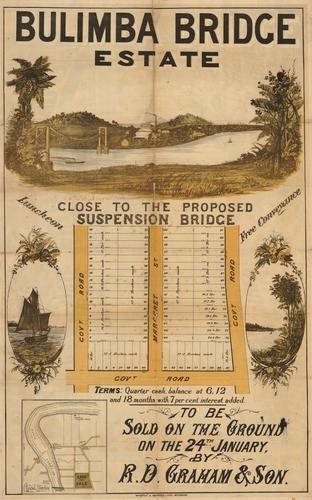
“Our firm was to have the selling of the estate, and it was old Catchall who suggested that it should be called Westmead. Remarkable man he was, and still is,” said Fielding, reflectively. “Never met with a man his equal at drawing up an advertisement for the sale of land.” …
“Well, the Honourable went down with me and the boss to look over the land. It was pretty rough in places, but M‘Watt was very cheerful; he said it would look quite different when it was cleared and the undergrowth burnt off, and said that as far as possible the streets and principle roads must run along the swamps and gullies.‘We shan't be at the expense of making them into good roads,’ he said, ‘and such things never show on the plans.’ ”
“Our firm then called for tenders for the clearing—paid a good price for it, and had it done to rights. There was a lot of ti-tree on it, but everything was cleared level with the surface, and carted to one corner of the ground, where it was burnt off. Then he actually had the grass eaten close down by a mob of horses. It had been very dry weather, but there was a shower or two of rain a fortnight before the sale, and to see the place pegged out when the surveyors had done with it was a picture. … The lithographs were really works of art, printed in colours, by a leading Sydney firm, regardless of expense.”
“There was a fancy picture of the estate, with several nice-looking houses near at hand. The artist must have drawn a little upon his imagination, for one place, that certainly looked like a villa residence in the picture, proved on inspection to be an old cow shed attached to an adjoining dairy farm. There was a distant glimpse, too, of the river, meandering placidly through sylvan glades. I nearly forgot to mention the railway line and station, by the way, which the artist inserted by express order of the Hon. Constant M‘Watt. He said‘the Minister had pledged himself to put it on the estimates.’ ” …
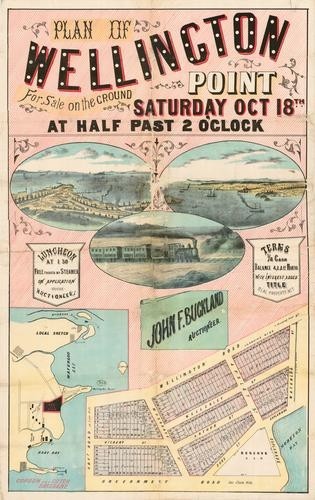
“Well, we had matchless weather, and Catchall was in splendid fettle. There was a string of two-horse waggonettes and omnibusses and cabs, placarded with announcements of the sale, and invitations to ride to the ground free of charge, which reached half way down Queen Street. At 12.15 a four-horse drag, with brass band and big placard, went round the city to remind the people of the great event. The syndicate worked well, too; most of them were present themselves, and came, bringing friends with them, in spanking turnouts with high-stepping pairs. …
There had been a large tent rigged up at one corner, with flag flying, and a spread laid out on long tables, such as many of them had never clapped eyes on before—fowls and turkeys, and hams, and great rounds of beef, and tongues; bottles of beer and wine, spirits with fancy gilt labels, unlimited fizz; and soft drinks for the teetotalars in any quantity. Well, Catchall, in his free and easy gentlemanly way, invites the whole crowd into lunch, and even pressed the Bishop to go and have a glass of wine and biscuit after his ride. How they did crowd the long tables, and swallow down the eatables and drink. …
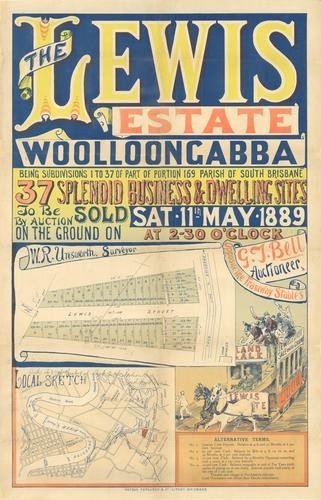
Lewis Estate map Woolloongabba
“After a while, old Catchall, who had a good tuck-in himself, looked at his watch and announced that it was time for starting, and that the luncheon booth would now be closed. His partner had the sales-book, and myself and another clerk stood on the corner pegs, to show the size of the allotments. After reading the terms of sale, which scarcely anyone could follow or understand, the auctioneer led the crowd to a twenty-eight perch corner allotment, on rising ground. It was, of course, the pick of the whole estate; and there he made, ‘pon my word, quite an eloquent little speech. He compared Australia to the United States, and spoke of the rapid rise and growth of some of the great American cities. He, in imagination, pictured the Brisbane of that day, side by side with the Brisbane of the future, and told how land which they could then buy by the perch, would in a few years be sold by the foot. Then he complimented them on their evident shrewdness and farsightedness, in having attended this highly important sale. He predicted that the allotments they would buy that day for a few pounds, on most advantageous terms, would, in a few years, realize tremendous prices. …
“The sale never once flagged, and what with excitement and drink, there's no doubt lots of purchasers gave double what they would have done for the same allotments if they had been sold privately. I remember, by the way, that Wright bought two allotments at the sale, and I believe they were in the worst part. But then, who thought anything about floods in those days. It's true one chap living in the neighbourhood did suggest it at the sale. But Catchall sat on him in a moment; said he had evidently been drinking too much of the vendor's beer, or he would never have thought of such a thing. I must confess, though, that I had my own misgivings, and so, I believe, had Catchall. But it was a splendid sale, and everybody, except the purchasers, made a pot of money out of it. …
As Fielding concluded his story the train swept suddenly round a curve and then ran down a rather steep decline, and in a moment, before them and all around, was a great sea of surging water, upon which several boats were busy rescuing the half drowned and, in many cases, wholly ruined residents.
“Good Heavens!” ejaculated Fielding. “It's awful, isn't it? Thank God, none of that money went into my pocket. Look there! I believe that child yonder is drowning. It may be Wright's child! It is near to his house—I remember it now. Ah! that boat has saved it. Is it possible!” and he groaned as he said it. “Under that water lies the land of the Westmead Estate.”
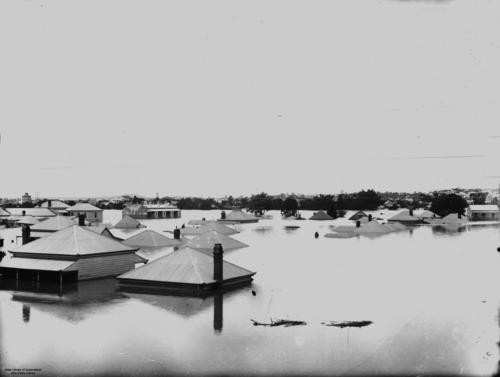
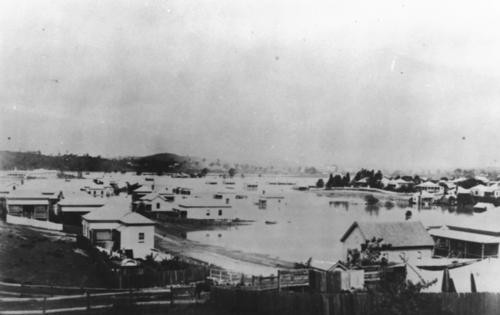
- Discover more from The Dishonourable in an exciting tale of rescue.
A daring rescue! : an extract from ‘The Dis-Honourable : a mystery of the Brisbane floods’ by David Hennessey (1895)
Comments
Your email address will not be published.
We welcome relevant, respectful comments.